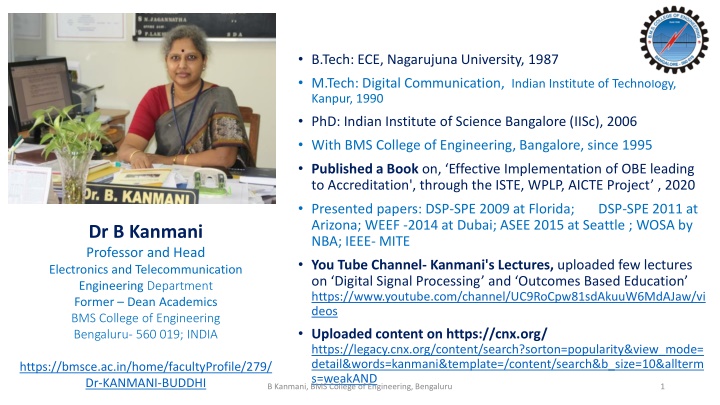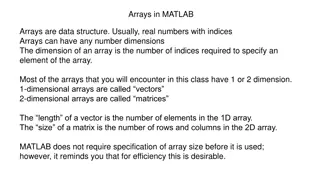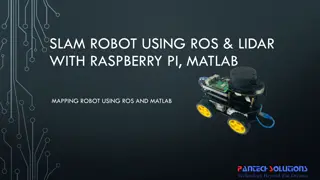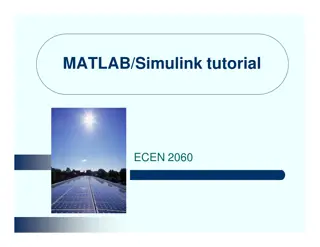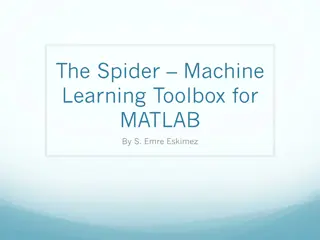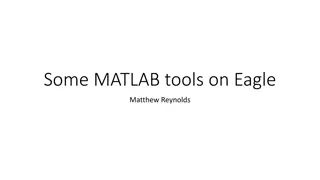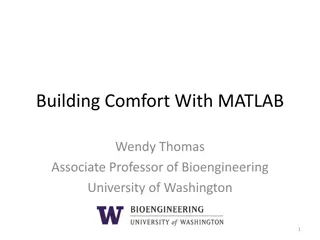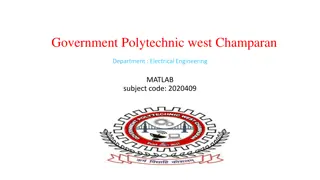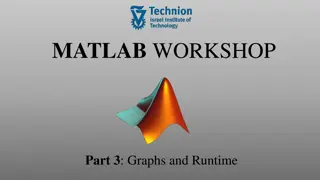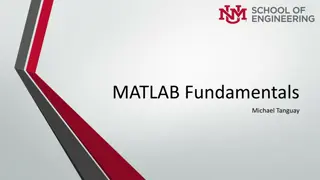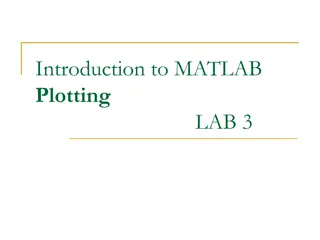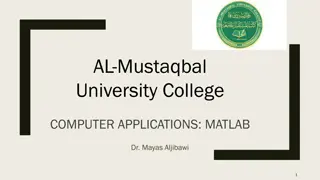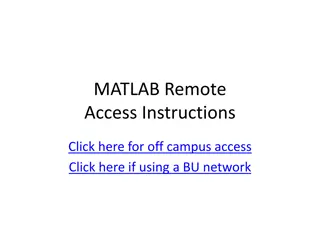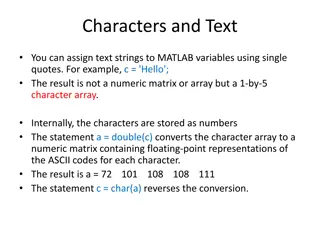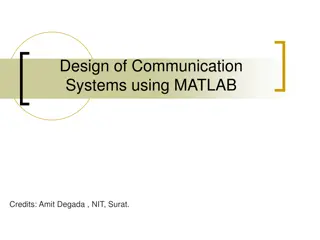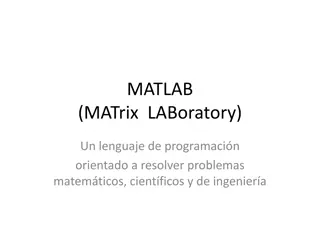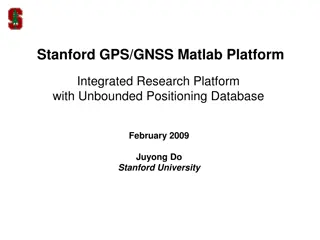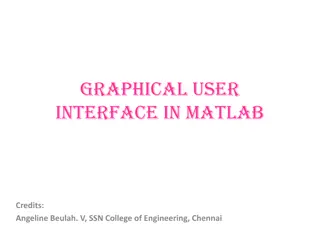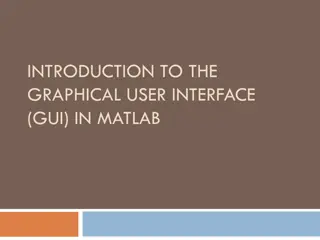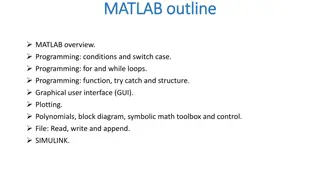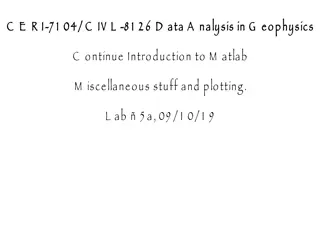Expertise in Digital Communication and MATLAB Programming
With a rich academic background and extensive teaching experience, Dr. B. Kanmani from BMS College of Engineering excels in Digital Signal Processing and MATLAB applications. Having published a book on OBE implementation and presented papers globally, Dr. Kanmani is renowned for innovative teaching methodologies and research in diffusion equations and programming approaches.
Download Presentation

Please find below an Image/Link to download the presentation.
The content on the website is provided AS IS for your information and personal use only. It may not be sold, licensed, or shared on other websites without obtaining consent from the author.If you encounter any issues during the download, it is possible that the publisher has removed the file from their server.
You are allowed to download the files provided on this website for personal or commercial use, subject to the condition that they are used lawfully. All files are the property of their respective owners.
The content on the website is provided AS IS for your information and personal use only. It may not be sold, licensed, or shared on other websites without obtaining consent from the author.
E N D
Presentation Transcript
B.Tech: ECE, Nagarujuna University, 1987 M.Tech: Digital Communication, Indian Institute of Technology, Kanpur, 1990 PhD: Indian Institute of Science Bangalore (IISc), 2006 With BMS College of Engineering, Bangalore, since 1995 Published a Book on, Effective Implementation of OBE leading to Accreditation', through the ISTE, WPLP, AICTE Project , 2020 Presented papers: DSP-SPE 2009 at Florida; DSP-SPE 2011 at Arizona; WEEF -2014 at Dubai; ASEE 2015 at Seattle ; WOSA by NBA; IEEE- MITE You Tube Channel- Kanmani's Lectures, uploaded few lectures on Digital Signal Processing and Outcomes Based Education https://www.youtube.com/channel/UC9RoCpw81sdAkuuW6MdAJaw/vi deos Uploaded content on https://cnx.org/ https://legacy.cnx.org/content/search?sorton=popularity&view_mode= detail&words=kanmani&template=/content/search&b_size=10&allterm s=weakAND B Kanmani, BMS College of Engineering, Bengaluru Dr B Kanmani Professor and Head Electronics and Telecommunication Engineering Department Former Dean Academics BMS College of Engineering Bengaluru- 560 019; INDIA https://bmsce.ac.in/home/facultyProfile/279/ Dr-KANMANI-BUDDHI 1
Teaching Digital Signal Processing using MATLAB as the Engineering Tool Dr B Kanmani Professor and Head Electronics and Telecommunication Engineering Department Former Dean Academics BMS College of Engineering; Bengaluru- 560 019; INDIA
Session Outline Experience with MATLAB The Programming Approach The need for a Tool MATLAB online The Pedagogy Changed Pedagogy Dream Graphical User Interface (GUI) The Success Story B Kanmani, BMS College of Engineering, Bengaluru
My Experience with MATLAB Research: Diffusion Equation pdetool box Teaching: Digital Signal Processing (close to 15 years) Under Graduate Engineering Program Core Course V Semester Class Strength of around 60 students MATLAB 2007; 2013; 2014; 2020 (online) IEEE Signals and Systems Concepts Inventory https://ieeexplore.ieee.org/document/1495653 B Kanmani, BMS College of Engineering, Bengaluru
The Programming Approach Ability to convert equation to CODE Mathematical Equation Code, without using inbuilt commands Use inbuilt command- verification Develop the CODE B Kanmani, BMS College of Engineering, Bengaluru 5
The Programming Approach Ability to convert equation to CODE Mathematical Equation Code, without using inbuilt commands Use inbuilt command- verification Develop the CODE Pen and Paper Code B Kanmani, BMS College of Engineering, Bengaluru 6
The Programming Approach Ability to convert equation to CODE Mathematical Equation Code, without using inbuilt commands Use inbuilt command- verification Develop the CODE Pen and Paper Code Introduce Commands as required No course in MATLAB B Kanmani, BMS College of Engineering, Bengaluru 7
The Programming Approach: An Example Code without using the in-built function Example: The Discrete Fourier Transform dft_matrix = zeros(N,N); for k = 0:N-1 for n = 0:N-1 dft_matrix(k+1,n+1) = exp(-2*j*pi*n*k/N); end end Verify using the in-built function XK = dft_matrix * xn XK = fft(xn,N); B Kanmani, BMS College of Engineering, Bengaluru 8
The Programming Approach: Another Example % Design of Analog Chebyshev Type I filter % Desired Filter Specifications Pass_Band_Ripple=3; Transition_ratio=0.25; Stop_Band_Loss=24; % to compute the filter order n epsilon=sqrt(10^(Pass_Band_Ripple/10)-1); A=10^(Stop_Band_Loss/20); omega_r=1/Transition_ratio; g=sqrt((A*A-1)/epsilon^2); n=log10(g+sqrt(g*g-1))/log10(omega_r +sqrt(omega_r^2-1)); n=ceil(n); % to compute the poles of the filter gamma=((1+sqrt(1+epsilon^2))/epsilon)^(1/n); sinhphi=(gamma-1/gamma)/2; coshphi=(gamma+1/gamma)/2; k=1:n; sigma_k=-sinhphi*sin((2*k-1)*pi/2/n); omega_k=coshphi*cos((2*k-1)*pi/2/n); poles=sigma_k + j*omega_k; % to get the denominator polynomial den=poly(poles); den=real(den); disp('Denominator polynomial by our computation'); disp(den) Code without using the in-built function Example: Chebyshev Filter (Type I) Verify using the in-built function % to verfiy the result with the inbuild Matlab command [AA BB]=cheby1(n,Pass_Band_Ripple,1,'s'); disp('denominator Polynomial using Matlab'); disp(BB) B Kanmani, BMS College of Engineering, Bengaluru 9
The need for the Tool With Pen and Paper 4- point DFT 8-point DFT Filter of order 7 Validate the design Beyond Pen and Paper Practical filters of higher order Need to use in-built functions Audio Eamples Filter audio Permit in-built function, projects B Kanmani, BMS College of Engineering, Bengaluru 10
Audio Example: in-built MATLAB function soundsc(data, Fs) % To define a sinusoidal signal Ts=1/N; Fs=1/Ts; t=0:Ts:1-Ts; freq=360; xn=cos(2*pi*freq*t); % To hear the a sinusoidal signal soundsc(xn,Fs) B Kanmani, BMS College of Engineering, Bengaluru 11
Audio Examples: in-built MATLAB function soundsc(data, Fs) % To define a sinusoidal signal Ts=1/N; Fs=1/Ts; t=0:Ts:1-Ts; freq=360; xn=cos(2*pi*freq*t); % To hear the a sinusoidal signal soundsc(xn,Fs) Extension: Get the audible range Guess the Frequency FUN: 240Hz; 270Hz; 300Hz; 320 Hz; 360Hz; 400 Hz; 450Hz; 480Hz; B Kanmani, BMS College of Engineering, Bengaluru 12
Audio Examples: in-built MATLAB function soundsc(data, Fs) Audio files (.wav) Hear the audio Spectrum of the audio Design a Filter Hear the filtered Audio Spectrum of the filtered audio Samples of musical instruments Hear noisy audio Filter noisy audio B Kanmani, BMS College of Engineering, Bengaluru 13
MATLAB online Switch to online teaching April 2020, got introduced to MATLAB online work from home work from college no need to save no need to send all students had access Online Teaching Labs B Kanmani, BMS College of Engineering, Bengaluru 14
MATLAB online Switch to online teaching April 2020, got introduced to MATLAB online work from home work from college no need to save no need to send all students had access soundsc(data, Fs) Story Zahida, MathWorks Technical Support from MathWorks B Kanmani, BMS College of Engineering, Bengaluru 15
The Pedagogy Concept: Fourier Series B Kanmani, BMS College of Engineering, Bengaluru
The Pedagogy Concept: Fourier Series Step 5: Laboratory Experiments Step 1: Statement (words) Step 4: Numerical Examples Step 2: Statement (Equation) Step 3: Proof (Mathematical) B Kanmani, BMS College of Engineering, Bengaluru
The Pedagogy Concept: Fourier Series Step 5: Laboratory Experiments Step 1: Statement (words) Step 4: Numerical Examples Assessment Define Fourier Series - YES Obtain Fourier Series - YES Step 2: Statement (Equation) Step 3: Proof (Mathematical) YES: 80% could answer B Kanmani, BMS College of Engineering, Bengaluru
The Pedagogy Concept: Fourier Series Step 5: Laboratory Experiments Step 1: Statement (words) Step 4: Numerical Examples Assessment Low Pass Filter (3KHz) ? Step 2: Statement (Equation) Step 3: Proof (Mathematical) 2 KHz 95% could not answer 19 B Kanmani, BMS College of Engineering, Bengaluru
Changed the Pedagogy Changed the Pedagogy: Experiential Learning : Experiential Learning Concept: Fourier Series MATLAB online Step 1: Laboratory Experiments Observation: Students make the statement B Kanmani, BMS College of Engineering, Bengaluru 20
Changed the Pedagogy Changed the Pedagogy: Experiential Learning : Experiential Learning Concept: Fourier Series MATLAB online Step 1: Laboratory Experiments Step 4: Proof (Mathematical) Step 5: Numerical Examples Observation: Students make the statement Step 3: Statement (equation) B Kanmani, BMS College of Engineering, Bengaluru 21
Changed the Pedagogy Changed the Pedagogy: Experiential Learning : Experiential Learning Concept: Fourier Series Step 1: Laboratory Experiments Step 4: Proof (Mathematical) Step 5: Numerical Examples Assessment Low Pass Filter (3KHz) ? Observation: Students make the statement Step 3: Statement (equation) 2 KHz 80% could answer B Kanmani, BMS College of Engineering, Bengaluru 22
A Dream: Collapse of Boundaries Curriculum- Courses A collapse in the boundaries of Lectures and Tutorials and Laboratory session The concept is supported by a laboratory experience All faculty shall handle all the laboratory sessions One Faculty handling the Theory Two or More Faculty handle the Laboratory sessions Synchronization between the Theory and Lab B Kanmani, BMS College of Engineering, Bengaluru 23
Another Dream Laboratory Record MATLAB Publish Students write the code (by hand) Draw the results (by hand) Attach Printout of the result Soft copy of records B Kanmani, BMS College of Engineering, Bengaluru 24
Workshop on GUI Building using Matlab A workshop on GUI building using Matlab was organized by Department of Telecommunication, BMSCE on October 21st 2016 (1.45 pm to 5 pm). The hands on session was conducted by Viju Ravichandran (Ph.D.), Education Technical Evangelist, Math Works, Bangalore and Ms. Maitreyee, Application Engineer, Math Works, Bangalore. This event was part of industry-institute interaction. A workshop on GUI building using App Designer was organized by Department of Telecommunication, BMSCE on October 282016 (1.45 pm to 5 pm). The hands on session were conducted by Viju Ravichandran (Ph.D.), Education Technical Evangelist, Math Works, Bangalore and Ms. Maitreyee, Application Engineer, Math Works, Bangalore. This event was part of industry-institute interaction.
Outcome of the GUI Workshop DSP Course Project SIX Teams of 10 to 12 students Each Team Build a Toolbox o Engineering Mathematics o Field Theory o Signals and Systems o Control Systems o Digital Signal Processing o Analog Communication Team Leader- concept for each member GUI integrate the contribution from all members Individual programs : YES Integration: NO All are awarded 5 marks In the OBE Framework A number of SLOs are addressed OBE: Outcomes Based Education SLO: Student Learning Outcomes B Kanmani, BMS College of Engineering, Bengaluru 26
The Proof of the Pudding . Publications from Project LORs Toolbox in DSP Course Students join our Program Awards Placements Higher Education https://bmsce.ac.in/reports/TE/Konnect_2020a.pdf https://bmsce.ac.in/reports/TE/Konnect_2021a.pdf B Kanmani, BMS College of Engineering, Bengaluru 27
The Proof of the Pudding . MathWorks India Private Limited Role: Associate in Engineering Development Group Eligibility: CS/IS/Circuit Branches Appeared online Test: around 200 Batch 2018 to 2022 Group Discussion; Technical Round; Managerial Round Total offers -7 from the college (3 ETE; 2-CSE; 1-ECE; 1-ISE) B Kanmani, BMS College of Engineering, Bengaluru 28
Double Edged Sword Any Engineering Tool can be used to enhance student learning Making the Best use of the Tool, is solely the responsibility of the Faculty B Kanmani, BMS College of Engineering, Bengaluru 29
Acknowledge Thank you! B Kanmani, BMS College of Engineering, Bengaluru 30
